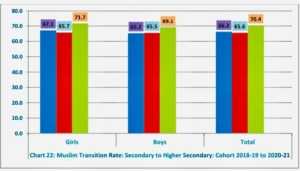Muslim Students Retention Rate at Primary, Elementary & Secondary Levels, Cohort 2020-21
The Retention Rates
Retention rates are vital indicators of an education system’s effectiveness in keeping students enrolled and engaged throughout their academic journey. This article analyzes the retention rates for the cohort 2020-21, focusing on primary (Grades 1 to 5) and elementary (Grades 1 to 8) levels. Computed based on the data from UDISE+ provides insights into the retention rates of all students and Muslim students specifically. Retention rates are computed at Grades V, VIII, X, and Grade XII depending upon data availability. Enrolment in Grades V, VIII, X, and XII in the present year (minus repeaters) is linked to Grade I enrolment five, eight, ten, and twelve years back.
Table 22: Efficiency Indicators: Cohort 2020-21 (All India)
|
Indicator Year 2021-22/Cohort 2020-21 |
Boys | Girls |
Total |
| Average Annual Dropout Rate | |||
| Primary (All Students) | 1.6 | 1.4 | 1.5 |
| Primary (Muslim Students) | 3.72 | 3.22 | 3.48 |
| Upper Primary (All Students) | 2.7 | 3.3 | 3.0 |
| Upper Primary (Muslim Students) | 5.58 | 5.68 | 5.63 |
| Elementary (Muslim Students) | 4.32 | 4.05 | 4.19 |
| Secondary (All Students) | 13.0 | 12.3 | 12.6 |
| Secondary (Muslim Students) | 18.59 | 18.69 | 18.64 |
| Transition Rate | |||
| Primary to Upper Primary (ALL) | 93.1 | 93.4 | 93.2 |
| Primary to Upper Primary (Muslim Students) | 88.61 | 89.97 | 89.28 |
| Elementary to Secondary | 89.7 | 87.8 | 88.8 |
| Elementary to Secondary (Muslim Students) | 82.57 | 81.38 | 81.97 |
| Secondary to Higher Secondary | 77.6 | 79.3 | 78.4 |
| Secondary to Higher Secondary (Muslim Students) | 69.13 | 71.66 | 70.43 |
| Retention Rate | |||
| Primary (1 to 5): All Students | 94.9 | 96.0 | 95.4 |
| Primary (1 to 5): Muslim Students | 96.01 | 92.19 | 94.02 |
| Elementary (1 to 8) ): All Students | 80.5 | 82.1 | 81.2 |
| Elementary (1 to 8) ): Muslim Students | 80.23 | 72.78 | 76.37 |
Source: Calculated based on UDISE+, different years.
Primary Level Retention: The retention rate for all Grades 1 to 5 students stood at an encouraging 95.4 percent, which indicates that nearly 95.4 percent of students in the cohort 2020-21 successfully continued their education to the next grade. Gender-wise, girls outperformed boys, with a retention rate of 96.0 percent compared to 94.9 percent for boys. However, we observe a slightly lower overall retention rate of 94.02 percent when focusing on Muslim students. Surprisingly, the retention rate for Muslim boys (96.01 percent) surpassed their female counterparts (92.19 percent), showcasing a gender reversal compared to the overall trend.
Elementary Level Retention: The transition from primary to elementary level saw a decline in retention rates. The overall retention rate for all students in grades 1 to 8 was 81.2 percent, suggesting that around 81.2 percent continued their educational journey to higher grades. Specifically, the retention rate for Muslim students was 76.37 percent, indicating that challenges exist in retaining this group within the education system. While Muslim boys exhibited a retention rate of 80.23 percent, Muslim girls faced more significant obstacles, with a lower retention rate of 72.78 percent.
The above analysis highlights several vital insights and challenges within the Indian education system:
Gender Disparities: Overall, girls demonstrated higher retention rates at primary and elementary levels, showcasing their educational commitment. However, there is a concerning trend among Muslim students, where female retention rates were notably lower. Addressing this gender disparity is crucial for fostering equal education opportunities.
Transition Challenges: The decline in overall retention rates from primary to elementary warrants attention. The education system must identify and address the factors leading to these drop-offs to ensure a smoother student transition between different academic stages. The data reveals that Muslim students face additional challenges in terms of retention rates compared to the overall student population. Implementing targeted support and inclusive policies can help bridge this gap and provide equal educational opportunities to all. Fostering an environment that supports student retention and progression is crucial to ensure a more equitable and robust education system. By addressing the challenges highlighted in this analysis, we can expect improvement in the transition rate of Muslim students.
Muslim Gross Enrolment Ratio at School Education in India (2021-22)
State-wise Muslim Gross Enrolment Ratio at School Education in India (2021-22)
Muslims Gross Enrolment Ratio at Higher Education Level (2020-21)
Muslim Gender Parity Index at Higher Education Level in India, 2016-17 to 2020-21
Average Annual Growth Rate: Muslim Enrolment in Higher Education
Share of Muslim Enrolment in Higher Education in India: 2016-17 to 2020-21
Number of Muslim Children Dropped-out between 2020-21 & 2021-22 in India
Muslim Students Transition Rate in India: Cohort 2018-19 to 2020-21




